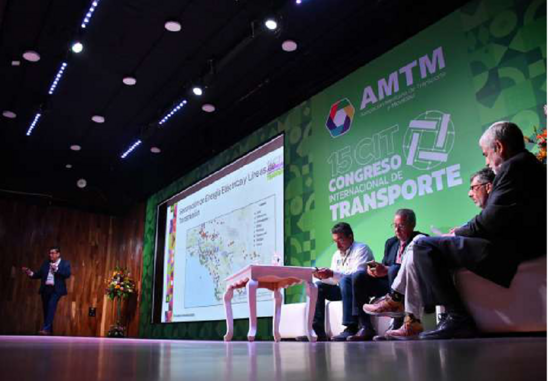CE-CERT Participates in the 15th International Transport Congress in Mexico City

The "Roundtable Discussion: Energy Needs and Prospects in Public Transportation," held during the 15th International Transport Congress, provided critical insights into the energy requirements and future prospects for public transit systems. This session, featuring Dr. Alfredo Martinez-Morales of the Bourns College of Engineering Center for Environmental Research and Technology at UC Riverside, emphasized the urgent necessity to transition to more sustainable energy sources to meet the increasing demands of urban mobility. Dr. Martinez-Morales and other experts highlighted the current challenges, including the heavy reliance on fossil fuels, the inefficiency of aging infrastructure, and the slow adoption of alternative energy technologies. These issues are particularly pressing given the significant contribution of public transportation to urban carbon emissions.
Dr. Martinez-Morales stressed the importance of integrating renewable energy sources, such as electric and hydrogen fuel cell technologies, into public transportation systems. Participants noted that while electric buses and vehicles are becoming more common, their adoption is still hindered by high initial costs, insufficient charging infrastructure, and the need for significant investments from both the government and the private sector. Successful examples from cities like Santiago, Chile, which has implemented a substantial fleet of electric buses, were cited as models that other urban areas could follow. These case studies demonstrate that with the right policies and investments, significant progress can be made toward reducing the carbon footprint of public transportation.
Additionally, the discussion addressed the need for comprehensive energy policies that support the integration of new technologies. These policies should not only focus on the transition to cleaner energy sources but also on enhancing the overall efficiency of public transportation networks. This includes optimizing routes, improving vehicle maintenance practices, and adopting smart technologies for better energy management. The panelists, including Dr. Martinez-Morales, advocated for a multi-stakeholder approach, involving government bodies, private companies, and the academic community, to drive innovation and ensure the sustainable development of urban transport systems.
A critical takeaway from the session was the role of public policy in facilitating this transition. Regulatory frameworks must evolve to support the deployment of renewable energy solutions and provide incentives for both public and private investments in sustainable transportation infrastructure. Additionally, there is a pressing need for educational initiatives to build capacity and expertise in managing and operating these new technologies. Training programs for transit operators and maintenance personnel are essential to ensure the smooth implementation and operation of energy-efficient transport systems.
The discussion also highlighted the socioeconomic benefits of transitioning to sustainable energy sources in public transportation. Reduced reliance on imported fossil fuels can enhance energy security, lower operating costs, and provide economic benefits through the creation of green jobs. Moreover, cleaner public transportation can significantly improve air quality, contributing to better public health outcomes and enhanced quality of life in urban areas.
For a summary of the conclusions and takeaways from the 15th International Transport Congress, please visit https://citamtm.org/wp-content/uploads/2024/06/memoria-15cit-final-web.pdf.